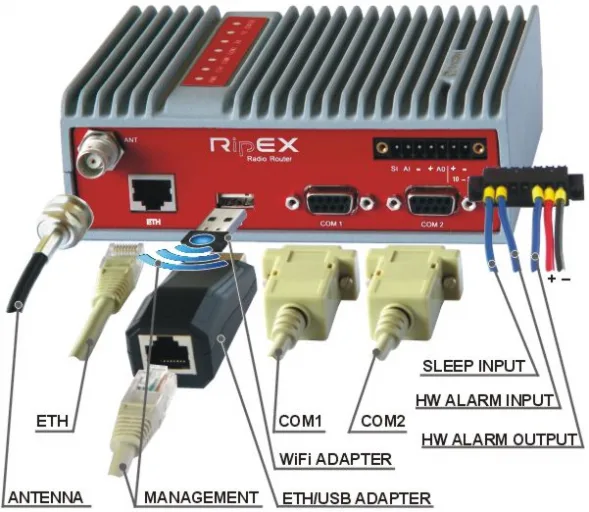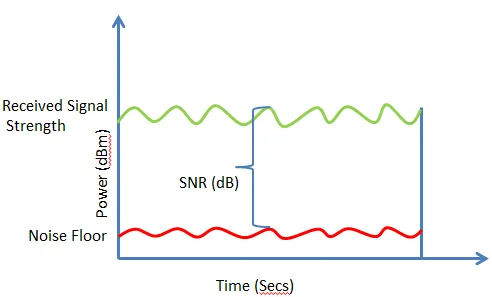Abstract
This report presents a new UHF radio modem design for use by search and rescue services. The modem is to be used a s communication link between an ambulance and a referral hospital. The objective is to connect the driver and the paramedics in the hospital seamlessly and in real-time. The design problem is reviewed in detail. A technical survey of the recent past works on the topic is done, and the various findings are briefly discussed. The major portion of the report involves a detailed description of the design requirements and their corresponding trade-offs. The various alternative parameters have also been examined, and the various drawbacks they face.
Introduction & Aims
Normally, it is demanding to perform diagnostic procedures during ambulance transportation of a victim using conventional clinical procedures. Achievement of improved diagnosis would, for instance, require constant data from life support instruments being sent to the referral hospital for analysis before the ambulance arrives. This report presents a new UHF radio modem design for use by search and rescue services. The designed system is a communication link between an ambulance on the move and the emergency section of a particular hospital. A step-by-step approach to the design problem, detailed design description, and lastly, design evaluation are done in this report.
The scope of the project is given in detail. Technical review has been done for the available telemetry schemes and related past works in the modern emergency response. The design requirements for a typical client are presented. In this case, the design parameters touch on the speed of the moving ambulance, the type of data to be communicated, the end-to-end handshaking protocols, frequency of operation of the radio modem, duplex modes for voice, signal to noise ratio (SNR) aspects and the signal compression schemes for both voice and still pictures.
The modem would be ideal for the current application case study since it operates wirelessly, which is desired for a moving vehicle. Secondly, radio frequency signals have wide area coverage before losing the signal strength; coverage could be up to 10 km. The signal integrity is less subject to interference since most UHF and VHF frequency bands are licensed by the state telecommunication regulator; a licensed frequency is usually preserved for a given user. The modem has a high bandwidth, which ensures data from life-support machines, digitized voice and still pictures taken via a digital camera are transmitted with minimal latency. In addition to search and rescue services, the radio modem is used in land survey differential fleet GPS, automated utility meter reading, fleet management and automated telemetry applications.
The Alternative Designs
Telemetry in Emergency Response
Sophisticated communication systems are critical for most emergency and rescue services as they relay information to relevant departments, such as paramedics, using modern communication technologies. Literature findings reveal that several attempts have been made to build reliable communication networks for emergency response using radio modems in ambulances (Brownrigg, 2014; Castellano et al., 2015; El-Dinary & Corp, 2016). Elsewhere, GPS and GPRS have been proposed as a potential telemonitoring system for emergency patient transportation (Satyanarayana et al., 2013). The acceptance of telemedicine by medical personnel is attributed to several social, cultural and technical factors that positively affected their attitudes (Hwang et al., 2014).
Existing Radio Modems
A SATEL Compact-4BT radio modem is modeled in (Anon. 2017), which has a long-range UHF multichannel radio modem and short-range Bluetooth connectivity. The frequency range of operation is between 403 and 473 MHz, translating into a tuning range of 70 MHz; this bandwidth may not be enough for accommodating more users at a given location and time, especially in applications involving cities. The operational bandwidth is 12.5kHz and 25 kHz, and both are software-selectable. The data transmission speeds are up to 28.8 kbps at a bandwidth of 25 kHz. It uses a +12 V – +30 Vdc lithium-ion battery for power supply, which may not be a reliable primary source of power. Notably, it uses TNC female connectors for connecting to the antenna. Cross-sectional studies show that the modem has no provision for connecting to the cloud via the Internet. Unlike in an ambulance, the modem would be useful in less mission-critical applications such as land surveying and automated agriculture.
Alternative studies (Anon., 2016) for the RipEX radio modem have shown that multiple frequency channels could be applied both in the VHF and UHF bands to achieve the same goal. Channel spacing could be achieved by using a 6.25/12.5/25/50 kHz sequence. The modulation schemes in place may be either the linear QAM, that is, D8PSK, π/4DQPSK, 16DEQAM and DPSK or the exponential QAM: 4CPFSK and 2CPFSK (Anon., 2015). The intermodulation attenuation is >40 dB, while the maximum receiver input power is 20 dBm, equivalent to 100 mW. The receiving end modem has an anti-aliasing selectivity of 50kHZ at -3 dB bandwidth. The power source voltage ranges from 10 to 30 Vdc. The peripheral devices are connected through 10/100 Base-T Ethernet, RS232 and RS485 serial, USB and TNC female connectors (Figure 1). Data speeds at a bandwidth of 12.5 kHz are >25 kbps, the typical value being 42 kbps (Anon., 2015). The radio modem is mechanically rugged; however, it is heavy and hence suitable for stationary applications.
Figure 1: RipEX radio modem showing the various connectors (Anon., 2016)
The Design Concept
Design Requirements
An optimal design was required, and select parameters were considered when choosing among several design approaches. The goal of the task was to design a modem consisting of network hardware that modulated carrier signals for voice and data, encoded digital information for transmission, and demodulated the signals for decoding of the transmitted information; this was to be done at ultra-high frequencies (UHF) of about 2 GHz. The UHF band in which the modem was to operate was within radio frequency range, hence the name radio modem.
Key Features
The communication network allows transmission of bio-medical related data from an ambulance on the move and the respective hospital. Additionally, it relays the data via the internet to enable cloud storage and analysis. Unlike most of the previous radio modems, this design allows for three nodes to be active simultaneously: the mobile unit, the base hospital and the real-time data analytics enhanced by remote receptor sites. Secondly, the design uses long-range, low-power technology.
The modem is preferred for its ruggedness, light weight and ability to provide maximum data transfer rates with minimal errors for the desired bandwidth. Another key feature is the three-step handshake protocol for the security of linking with the receiver modem; this is necessary as it locks out intruders. The modem connects to the hospital via a line of sight link as well as a cellular network, which provides a connection to the internet, which backhauls to the hospital, too. The radio modem utilizes even the weak network in sparsely populated areas with poor connection by using a redundant 2G connection, hence maximizing the uptime.
The mobile unit moves at high speeds, which affects its ability to send and receive data. The solution to this problem is found by employing an LOS connection using the Yagi antenna; such connections are reliable up to lengths of about 10 km length. However, LOS may not always be achieved in certain terrains; hence, alternative methods need to be applied. Normal public cellular networks may be applied where the use of frequency hopping (FH) ensures that signal integrity is maintained between the mobile unit and the base location.
In frequency hopping systems, the modem in the ambulance avoids the issues of communication failure at specific frequencies caused by fade or channel interference. The signal from the ambulance detects a unique channel and a different combination of interfering factors with each hop. Selection of the frequency hopping type proves a challenging task for an engineer. Two classes of frequency hopping exist. These are slow frequency hopping (SFH) and fast frequency hopping (FFH).
The SFH is preferred in this design for a number of reasons. First, multiple data bit transmission is possible within one hop. Secondly, coherent data detection is possible. Most FSH systems permit coherent detection and burst error control coding, hence restoring lost bits in a single hop. The other kind, FFH, involves one data bit being divided over several hops. The downside of this method and the main reason behind its lack of selection in our design is the difficulty experienced in coherent detection. The modulation techniques associated with this approach are mainly frequency shift keying (FSH) and multiple frequency shift keying (MSFH).
As a key basic modulation technique with applications in spread spectrum communications, frequency hopping is intrinsically secure and reliable under diverse conditions. There are a few bottlenecks overlooked in the selection of the frequency hopping technique. FH is associated with low data rates, narrow bandwidth frequency hopping and low hopping rate in higher frequencies (Deepak et al., 2017). The design data rate of the UHF radio modem is limited to 2400 bps and reliably stable at 1200 bps with the highest hoping rates being only ten hops per sec. The data rates, despite being low, will have minimal effect on the availability of life-support machines that transmit data at lower speeds of 200 bps. The anti-jamming capability is less, however, techniques such as Markov decision process (Kresimir, et al., 2014) have been recommended for channel prediction, reducing that shortcoming.
Modulation and Demodulation
Transmission of a signal over a network requires that the signal-bearing wave characteristics be adaptable to the properties of the available transmission channel, in particular air. Modulation by the modem helps achieve this by transforming the electromagnetic signals into a predefined bandwidth known as a passband. The passband is equivalent to the bandwidth of the desired radio modem, which is 12 kHz. The implication is that an effort is required to send more information over the modem’s narrow passband. Pulse shaping is thus necessary to constrict the bandwidth within the predefined limits and can be done through a linear filtering operation.
The frequency of operation is about 2 GHz and the radio modem will only be allowed to transmit over a prescribed bandwidth of 12 kHz.. Data transmission via a channel is analog by default. However, digital modulation techniques are applied in the digital domain up to the digital/analogue conversion stage. A typical digital modulator that could be used in the radio modem is shown in Fig. below. The sources of the digital data include the digitized voice, life support systems and still pictures. The mapper’s work is to uniquely map each possible 2m group combination of data streams into a symbol b in the modulator circuit. Symbols represent the signal amplitude value in terms of voltage equivalent; they fall under a finite alphabet A of magnitude M = 2m. The mapper generates a newly unmatched symbol for each time period T = M/R sec. The value T-1 is called the baud rate.
Figure 2: A digital modulator of the radio modem.
The symbols on the mapper output occur in the sequence say, bi. The sequence is made suitable by first establishing the spectral characteristics. The approach is used as it helps ensure that all the symbols fit into the available but limited bandwidth. The spectral characteristics are frequency-transformed right into the passband of the channel using the pulse shaper (a low pass filter).
The end of the sampler has a digital-to-analog converter. According to the Nyquist rate, the sampling frequency for the D/A is chosen such that it is at least twice the bandwidth (Proakis, 2003). The sampling frequency for the modem is fs ≥ 24000 Hz. The sampling present in the modulator thus takes place at an internal sampling frequency independent of the D/A converter. Specifically, the upper limit and lower limit passband frequencies will be: ωmax = 2π(fmax/fs) and ωmin = 2π (fmin/fs) respectively. The passband width is the difference between the two limits: ωmax – ωmin = 2π ((fmax −fmin)/fs), while the center band carrier frequency is ωcenter = π ((fmax +fmin)/fs. The real value of fs is subject to two conditions for an error-free data rate that could be sent through the system. First, the sampling frequency is more than twice the channel’s passband upper-frequency limit, that is, fs> 2 max; secondly, fs = K(1/T), where fs is a baud rate multiple, and K is an integer.
Codecs and Compression
Bandwidth is a scarce resource, while raw media demands data capacity; minimizing data transmission requirements is essential. The reduction of data rates checks the amount of data needed to convey both voice and still pictures. Digital information transmission requires both signal compression and coding on the transmitter end. The receiver end does both decompression and decoding of images and audio. The codec in a radio modem can either be hardware-defined for the compression and decompression of digital pictures and audio signals or simply a software program that encodes analog signals into digital bits and decodes digital bits into analog signals.
There are three types of compression: lossy, lossless and uncompressed. In lossy compression, an algorithm may be used to compress content, however, some data is lost permanently. Lossless uses an algorithm that allows original data to be recovered and replicated using decompression-appropriate schemes. Uncompressed is when original data is unchanged; this is eliminated in the modem design since it wastes otherwise useful space. The modem will utilize a lossless compression technique for its obvious benefits, that is, minimal signal loss.
A proper scheme is necessary for the modem to be functionally robust. There are known methods of encoding and decoding speech and still pictures. Speech coding techniques associated with GSM include FR (full rate coding), enhanced full rate (EFR) coding (Jarvinen et al., 1997) and adaptive Multi-Rate (AMR) audio codec (Bessette et al., 2002). The bit rate of the FR codec is 13 kbps with however, poor quality speech relative to modern standards. The EFR is a speech coding standard that improves the poor quality voice of the FR, with a bit rate of 12.2 kbps. The modem utilizes the latest and most advanced AMR audio codec specially optimized for speech coding. The AMR samples speech at 8 kHz frequency using 13-bit code, that is, 160 samples for 20 ms frames with filtration done for the range 200-3400 Hz. Besides being desirably low, the bit rate allows enough space for sampling still pictures and life-support instrument data to be sent via the same radio modem.
Error Detection and Correction
Error detection can be performed in various layers depending on the communication model used. The data link layer will be used to detect errors in the designed radio modem. The cyclic redundancy checksum (CRC) method will enable error detection. It is efficient in error detection compared to both parity and longitudinal parity error detection techniques (Curt, 2011). Table 1 below shows the type of errors that CRC detects and the percentage accuracy of detection.
Table 1: Performance of CRC error detection method (Curt, 2011, p. 177)
| Error type | Error Detection Level |
| Single-bit errors | 100 % |
| Double-bit errors | 100 % (generating polynomial should have at least three 1s) |
| Odd number of bits-in-error | 100 % (generating polynomial should have a factor y+1) |
| Error burst of length < x+1 | 100% |
| Error burst of length = x+1 | prob. = 1 – (1⁄2)(x –1)(close to 100%) |
| Error of length > x+1 | prob. = 1 – (1⁄2)x (close to 100%) |
Error correction involves restoration of the original message by eliminating the detected errors, mainly done through the forward error correction approach. For a receiver to be able to fix an error through simple forward error correction, redundant information is required for identification of the bits in error. The approach is, however, limiting in that even for a simple error, it is required that three times the data must be transmitted. The modem, by design, uses an alternative and explicit forward correction mechanism: the Hamming code. Creation of a self-error-correcting or rather forward error-correcting code, only an appropriate distance and a code are defined and created, respectively.
Duplex mode and Priority scheduling
The radio modem is configured into 3 channels. The first channel is critical and hence scheduled with the highest priority since it connects the life-support machine to the hospital. The second most important communication aspect to be prioritized, although on a smaller scale, is the two-way voice transmission. The voice channel will be critical in feedback response and, hence, can be implemented using a full duplex. The mode has bidirectional transmission of the ambulance driver’s speech to the paramedics in the health care center. However, this mode suffers one major drawback, which is highly undesirable for emergency response applications: high latency measured in milliseconds. The latency problem will be hopefully solved once 4G network has been availed to most parts of the country.
Half-duplex mode would also be suitable since it supports two-way traffic, but the information is transmitted in one direction at a time. Half duplex eliminates the need to have two links within a channel, that is, uplink and downlink, hence preserving the little bandwidth available. Half-duplex gadgets (walkie-talkies) are robust, easy to use, and perform well in places with poor cellular network coverage, such as forests. On the other hand, most cellular gadgets are full duplexes and can have access to the internet as well as transmit media files such as still and motion pictures. An ambulance may use the full duplex, which supports digital modulation, and a half-duplex voice transmission capability for redundancy (cases of poor cellular network), as is the case for Terrestrial Trunked Radio even though the cost would be slightly escalated (Simon & Kat, 2015).
Signal-to-Noise Ratio
The SNR value translates into the power ratio between a signal and the background noise. To ensure good performance when performing network functions, the modem’s minimum SNR is set at 15 dB below which is low with little or no sync issues. The SNR value of 50 dB and above indicates an outstanding signal that the modem easily differentiates the signal from the noise. Figure 3 below shows that the SNR value can also be calculated by getting the difference between the measured received signal and the defined noise floor.
Figure 3: Measuring SNR given both the received signal and the noise floor
Conclusion
The need for improved design features of the radio modem has been widely discussed. With the advances in technology, the need for a fast, reliable and robust ambulance communication system has been emphasized. The design of a UHF range radio modem with relevant features for the specific application is a daunting task, and a careful selection of features has been considered. The incorporation of new technology features does not necessarily translate into the best design for the specific application. Ambulances give urgent attention when the need arises. Life-support machines embedded in an ambulance are of utmost importance, hence given the first priority network connection. Several design requirements considered are bandwidth requirements, use of digital modulation techniques, error detection and correction, codec, compression and priority scheduling, among others.
References
Anon., 2015. RipEX Radio modem & Router: User manual. Mirova: Racom Radio Data Networks.
Anon., 2016. RipEX – Radio modem & Router User Manual. [Online]
Available at: http://www.racom.eu/eng/products/m/ripex/product.html#det_param
[Accessed 20 April 2018].
Anon., 2016. RipEX – Radio modem & Router. [Online]
Available at: http://www.racom.eu/eng/products/radio-modem-ripex.html#specifications
[Accessed 20 April 2018].
Anon., 2017. Quality radio modems for wireless data communication: SATEL Compact-4BT. [Online]
Available at: https://www.satel.com/products/radio-modems/satel-compact-4bt/
[Accessed 20 April 2018].
Banuelos, n.d. Thesis Draft Introduction. [Online]
Available at: https://www.nyu.edu/tisch/preservation/program/…/13s_Thesis_banuelos_a1.pdf
[Accessed 21 April 2018].
Bessette, B. et al., 2002. The adaptive multirate wideband speech codec (AMR-WB). IEEE Transactions on Speech and Audio Processing, 10(8), pp. 620-636.
Brownrigg, E., 2014. Citizens’ emergency network system and method. U.S., Patent No. Patent 8,630,301.
Castellano, N. N. et al., 2015. Design of a real-time emergency telemedicine system for remote medical diagnosis.. Biosystems Engineering, Volume 138, pp. 22-32.
Curt, M. W., 2011. Data Communications and Computer Networks: A Business User’s Approach. 6 ed. Boston(MA): Cengage Learning.
Deepak, B. R., P. Shyamala, B. & Dhananjay, K., 2017. Radio Frequency Anti-jamming Capability Improvement for Cognitive Radio Networks: An evolutionary game theoretical approach. Chennai, India, s.n.
El-Dinary, A. S. & Corp, i. D., 2016. Systems and Methods for Emergency Vehicle Proximity Warnings Using Digital Radio Broadcast. U.S., Patent No. Patent Application 14/957,797.
Hwang, J. Y., Kim, K. Y. & Lee, K. H., 2014. Factors That Influence the Acceptance of Telemetry by Emergency Medical Technicians in Ambulances: An Application of the Extended Technology Acceptance Model. Telemedicine and e-Health, 20(12).
Jarvinen, K. et al., 1997. GSM enhanced full rate speech codec. In Acoustics, Speech, and Signal Processing,. s.l., IEEE, pp. 771-774.
Kresimir, D., Alejandro, B., Lucio, M. & Carlo, S. R., 2014. Intelligent cognitive radio jamming – a game-theoretical approach. EURASIP Journal on Advances in Signal Processing.
Proakis, J., 2003. Companders. s.l.:Wiley Encyclopedia of Telecommunications.
Satyanarayana, K. et al., 2013. GPS and GPRS based telemonitoring system for emergency patient transportation. Journal of Medical Engineering, Volume 2013.
Simon, R. & Kat, H., 2015. Police Radios will be killed soon – yet no one dares say Huawei. [Online]
https://www.theregister.co.uk/2015/01/08/airwave_tetra_switch_off_gov_service_onmishambles/
[Accessed 22 April 2018].
Appendix
Figure 1: RipEX radio modem showing the various connectors (Anon., 2016) 6
Figure 2: A digital modulator of the radio modem. 9
Figure 3: Signal to noise ratio of a signal 14
Table 1: Performance of CRC error detection method (Curt, 2011, p. 177) 12
4G – 4th generation
AMR – adaptive multi rate coding
CRC – cyclic redundancy checksum
D/A- digital to analogue converter
DPSK – differential phase shift keying
EFR – enhanced full rate coding
FH – frequency hopping
FR – full rate coding
FSH – fast frequency hopping
GPRS – General Packet Radio Services
GPS – global positioning system
LOS – line of sight
QAM – quantized amplitude modulation
SFH -slow frequency hopping
SNR – signal to noise ratio
TNC – Threaded Neill–Concelman connector
UHF – ultra high frequency (frequency range 300 MHz -3 GHz)
USB – universal serial bus
VHF – very high frequency (frequency range 3 MHz-300 MHz)
Cite This Work
To export a reference to this article please select a referencing stye below:










